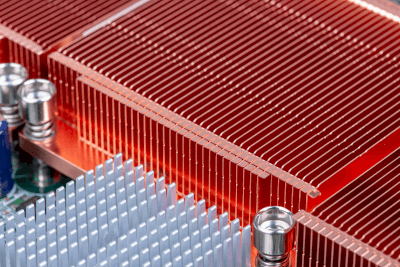What Is Thermal Interface Material?

Thermal Interface Material (TIM) is crucial in managing heat in devices, especially with the increasing performance and miniaturization of products. TIMs are used to protect products from heat by facilitating efficient heat transfer.
With the sophistication of electronic devices, heat management becomes critical. Without adequate heat dissipation, there can be impacts on product performance and even risks to mechanical integrity and human health. As devices miniaturize, their ability to dissipate heat reduces since heat can only escape from surfaces.
Traditional methods like natural air cooling are reaching their limits, and as a result, innovative heat dissipation methods are becoming increasingly important.
Heat dissipation typically occurs from the surface area of components. However, as components shrink in size, their surface area decreases, leading to heat aggregation. This is evident in components like capacitors, diodes, and transistors on electronic circuit boards, where the heat generated can affect surrounding components.
The relationship between substrates and components has evolved, with current components having smaller surface areas and hence transferring more heat to the substrate, affecting adjacent components even in cooler ambient air.
TIMs are designed to address these challenges.
Applications of Thermal Interface Material
TIMs are used across various industries, especially in electronic components. They include thermally conductive materials (TIMs) and heat sinks, with TIMs being used for smaller products and heat sinks for larger ones.
- Thermal Interface Material (TIM)
TIM, or Thermal Interface Material, is a heat-conductive material placed between components to dissipate heat. It reduces thermal resistance caused by an air layer between the heat source and the cooler, thus facilitating efficient heat transfer. Common materials for TIMs include boron nitride, aluminum nitride, alumina, and carbon-based sheets, as well as heat-dissipating grease. - Heat Sinks
Heat sinks are designed to dissipate heat efficiently and typically consist of fins or plates with a large surface area. They are used in applications where space allows for a large surface area.
How to Select Thermal Interface Material
The selection of TIMs is based on thermal design principles. Designers consider factors like total heat generation, allowable temperatures, dimensional restrictions, and the environment where the equipment will be installed. It is crucial to ensure compatibility of the TIM with the conditions of the installed equipment to avoid any unintended interference or accidents.
In the automotive industry, for example, TIMs are used in metal and molded plastic parts, but careful selection is necessary to prevent interference with radio wave transmission in electronic devices.
Types of Thermal Interface Material
TIMs include not only thin materials like sheets but also heat pipes, vapor chambers, heat-dissipating coatings, fans, and grease. These materials are used in various applications, from personal computers to automotive parts, and are chosen based on specific requirements like thickness, solubility, and thermal radiation properties.
- Heat Pipes
Heat pipes use the latent heat of evaporation of a working fluid to transport and dissipate heat. They are maintenance-free and used in a variety of applications. - Vapor Chamber
Vapor chambers work similarly to heat pipes but are thinner and smaller, suitable for applications like smartphones and smart glasses. - Heat Dissipating Coatings
These coatings dissipate heat by radiating it as electromagnetic waves rather than relying on the thermal conduction efficiency of the paint film. They are used in motors, engines, exhaust products, lighting, and heat sinks. - Heat Dissipation Fan
Using forced-air cooling, these fans are mainly used in computers, servers, power supplies, and power distribution boards. - Heat-dissipating Grease
Thermal grease improves thermal conductivity and is used to lower thermal resistance, often referred to as CPU grease.